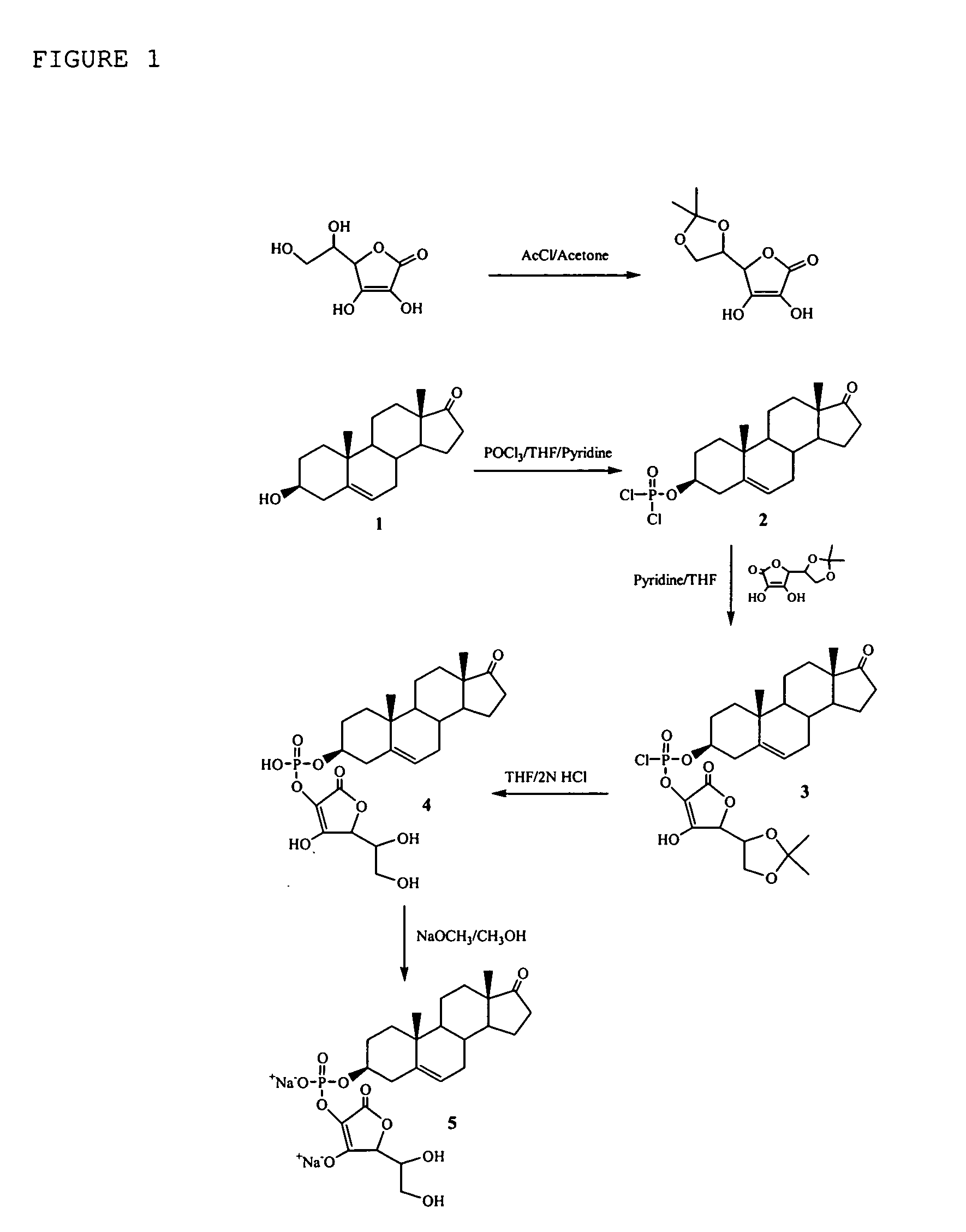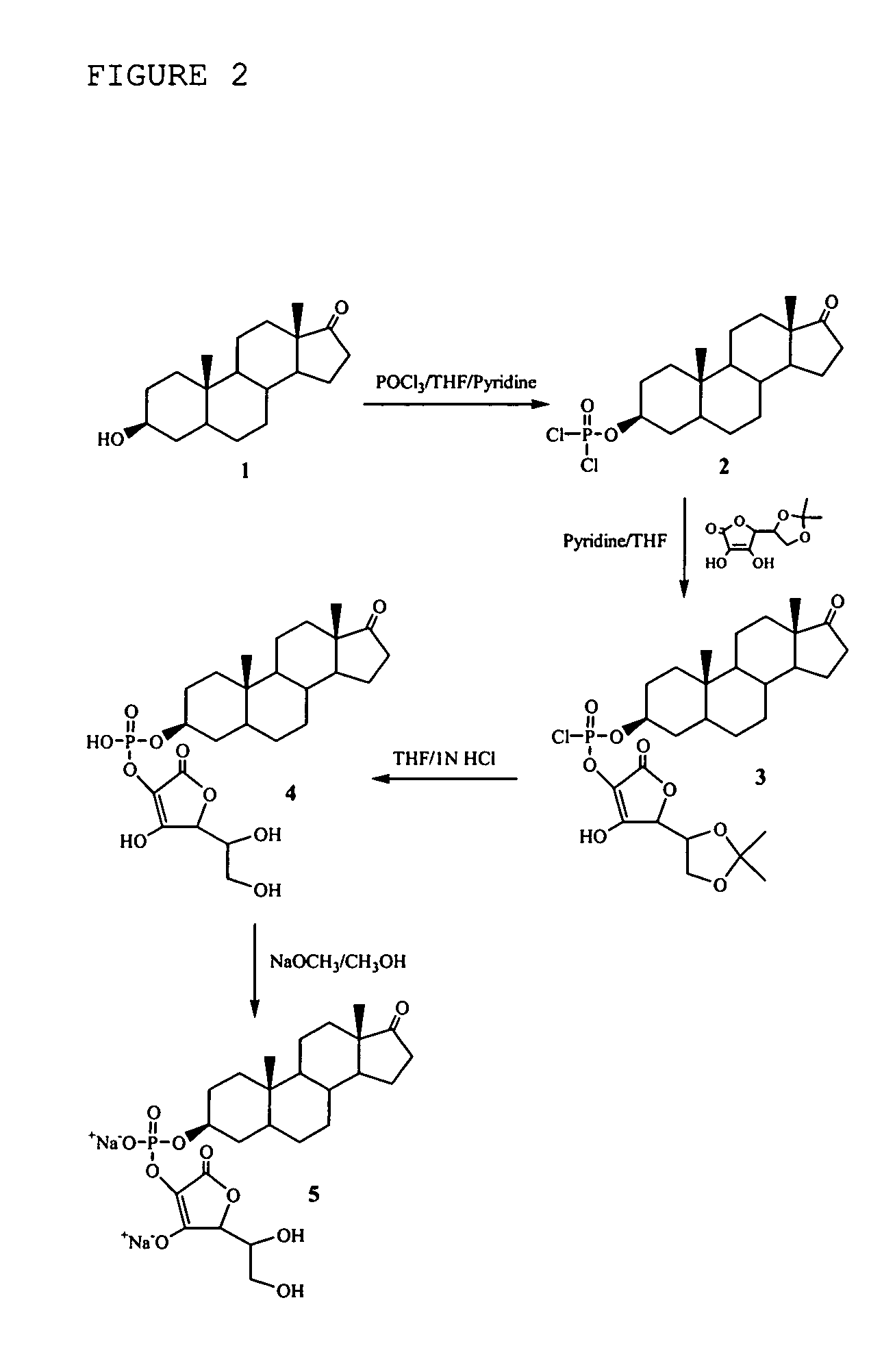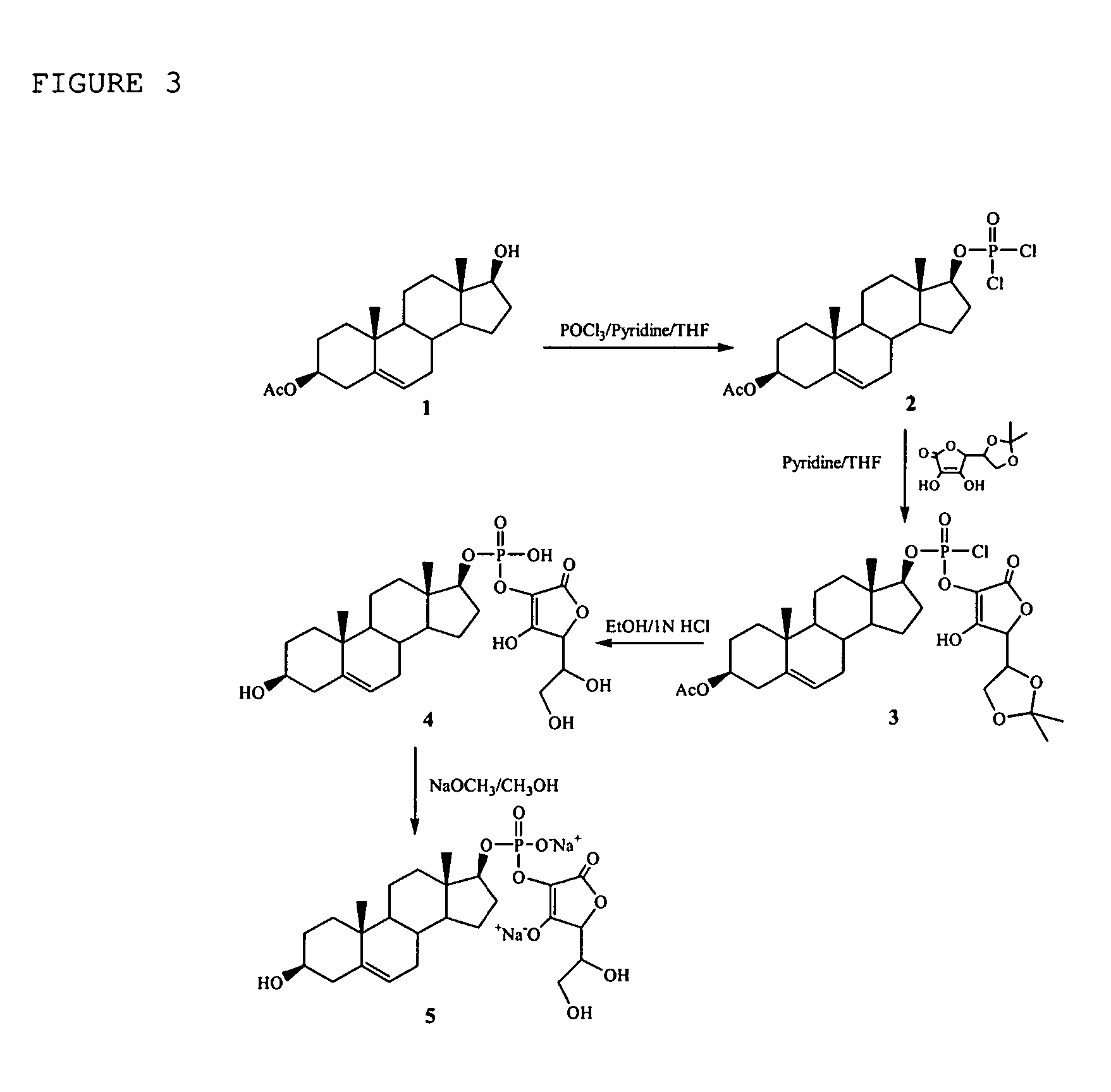Compositions comprising one or more policosanols and/or policosanoic acids combined with sterol and/or steroid based ascorbic acid derivatives, and uses thereof
a technology of policosanoic acid and derivatives, which is applied in the direction of biocide, plant growth regulator, animal husbandry, etc., can solve the problems of increased risk of death from cvd, increased serum cholesterol, and insufficient treatment of the underlying cause of cardiovascular disease (“cvd”), and achieves enormous potential and reduces ldl cholesterol
- Summary
- Abstract
- Description
- Claims
- Application Information
AI Technical Summary
Benefits of technology
Problems solved by technology
Method used
Image
Examples
example 1
Preparation of Compounds of Formulae I-III
Protection of Ascorbic Acid and Synthesis of Disodium Ascorbyl Phosphate Ester of Dehydroisoandrosterone
[0189] To a dry round bottom flask, acetone (150 ml) and L-ascorbic acid (50 g) were added at 0° C. Acetyl chloride (7.5 ml) was added dropwise through an addition funnel in 10 minutes. The reaction mixture was stirred at 0° C. for 24 hours. The precipitate was filtered off and washed with acetone (3×20 ml). The white product, 5,6-isopropylidine ascorbic acid, was dried under vacuum for 1.5 hours to give a dry powder (52 g), yield 85%.
[0190] A dry three neck round bottom flask was fitted with a stirring bar, argon inlet and an addition funnel. A solution of dehydroisoandrosterone (FIG. 1, 1.73 g, 6 mmol) in anhydrous THF (15 ml) and pyridine (2.4 ml) was added dropwise to the mixture of anhydrous THF (12 ml) and POCl3 (0.7 ml, 7.5 mmol) at 0° C. over a period of 10 minutes. A white precipitate formed immediately. The suspension was stir...
example 2
Preparation of Compounds of Formulae I-III
Synthesis of Disodium Ascorbyl Phosphate Ester of 5α-Androstan-3β-ol-17-one
[0194] To a dry round bottom flask, 5α-androstan-3β-ol-17-one (1.0 g, 3.4 mmol), THF (8.6 ml) and pyridine (1.38 ml) were added. The mixture was stirred at room temperature until a clear solution was obtained. To another dry round bottom flask, THF (6.9 ml) and POCl3 (0.4 ml, 4.25 mmol) were added, stirred at 0° C. for 5 minutes. To this mixture, the above prepared 5α-androstan-3β-ol-17-one solution was added drop-wise under argon atmosphere over a period of 10 minutes. After the addition, the white suspension was stirred at 0° C. for 35 minutes, and at room temperature for 2 hours. The reaction was stopped and the white suspension was used for the coupling reaction without filtration.
[0195] 5,6-Isopropylidine ascorbic acid (2.0 g, 9.52 mmol) was dissolved in pyridine (1.71 ml) and THF (17 ml). The round bottom flask which contained previously prepared white suspen...
example 3
Preparation of Compounds of Formulae I-II Synthesis of Disodium Ascorbyl Phosphate Ester of Androst-5-ene-3β,17β-diol
[0198] To a dry round bottom flask, 3β-acetoxyandrost-5-ene-17β-ol (1, FIG. 3, 1.0 g, 3.0 mmol), anhydrous THF (6.3 ml) and pyridine (0.73 ml) were added. The mixture was stirred at room temperature until a clear solution was obtained. To another dry round bottom flask, THF (2 ml) and POCl3 (0.35 ml, 3.22 mmol) were added, stirred at −5° C.˜-10° C. for 5 minutes. To this mixture, the above prepared 3β-acetoxyandrost-5-ene-17β-ol solution was added drop-wise under argon atmosphere over a period of 20 minutes. After the addition, the white suspension was stirred at room temperature for 1 hour. The mixture was concentrated to remove THF and excess POCl3 to give a residue (2, FIG. 3).
[0199] 5,6-Isopropylidine ascorbic acid (0.98 g, 4.55 mmol) was dissolved in anhydrous pyridine (0.70 ml) and THF (6.2 ml). The residue (2, FIG. 3 dissolved in dry THF (4 ml). To this mixtu...
PUM
| Property | Measurement | Unit |
|---|---|---|
| temperatures | aaaaa | aaaaa |
| temperature | aaaaa | aaaaa |
| diameter | aaaaa | aaaaa |
Abstract
Description
Claims
Application Information
 Login to View More
Login to View More - R&D
- Intellectual Property
- Life Sciences
- Materials
- Tech Scout
- Unparalleled Data Quality
- Higher Quality Content
- 60% Fewer Hallucinations
Browse by: Latest US Patents, China's latest patents, Technical Efficacy Thesaurus, Application Domain, Technology Topic, Popular Technical Reports.
© 2025 PatSnap. All rights reserved.Legal|Privacy policy|Modern Slavery Act Transparency Statement|Sitemap|About US| Contact US: help@patsnap.com



